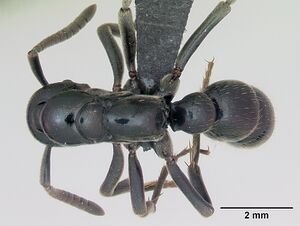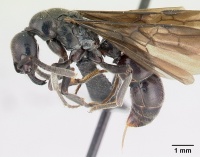Euponera sikorae
| Euponera sikorae | |
|---|---|

| |
| Scientific classification | |
| Kingdom: | Animalia |
| Phylum: | Arthropoda |
| Class: | Insecta |
| Order: | Hymenoptera |
| Family: | Formicidae |
| Subfamily: | Ponerinae |
| Tribe: | Ponerini |
| Genus: | Euponera |
| Species: | E. sikorae |
| Binomial name | |
| Euponera sikorae (Forel, 1891) | |
Generally nests in rotten logs and dead branches on the forest floor. Worker specimens have been found foraging mostly on the ground and in the leaf litter, and rarely on low vegetation.
| At a Glance | • Gamergate |
Identification
Rakotonirina and Fisher (2013) - Worker. Anterior margin of clypeus broadly transverse and straight, with slight median notch; mandible striate-punctate; posterior margin of head straight or broadly rounded; antennal scape surpassing posterior cephalic margin; metanotal groove deeply impressed; promesonotum clearly convex; posterior margin of propodeum and petiole node rounded in profile, but truncate when viewed dorsally; anterior surface of third abdominal segment straight, not forming shallow cavity; integument covered with brownish slender hairs; larger species (HW: 1.63–1.8 mm); overall a smooth and glossy black ant.
Of the several species with a deeply impressed metanotal groove and straight anterior clypeal margin, E. sikorae is the largest in size (HW 1.63–1.98, WL 2.85–3.29) in the group and most easily recognized by its smooth and shiny black integument, with bluish reflection, which is covered with golden pubescence.
Keys including this Species
Distribution
Rakotonirina and Fisher (2013) - Euponera sikorae is an endemic, widespread species that is distributed across the humid forest habitats in eastern Madagascar and occurs at a wide range of altitudes, from lowlands to high mountains. In the north of the island, its distribution ranges from the RS Manongarivo in the west to the PN Marojejy in the east, down to the PN Zahamena in the central east, through the PN Ranomafana and down to the PN Andohahela in the south.
Latitudinal Distribution Pattern
Latitudinal Range: -12.8047° to -24.7639°.
| North Temperate |
North Subtropical |
Tropical | South Subtropical |
South Temperate |
- Source: AntMaps
Distribution based on Regional Taxon Lists
Malagasy Region: Madagascar (type locality).
Distribution based on AntMaps
Distribution based on AntWeb specimens
Check data from AntWeb
Countries Occupied
| Number of countries occupied by this species based on AntWiki Regional Taxon Lists. In general, fewer countries occupied indicates a narrower range, while more countries indicates a more widespread species. |

|
Estimated Abundance
| Relative abundance based on number of AntMaps records per species (this species within the purple bar). Fewer records (to the left) indicates a less abundant/encountered species while more records (to the right) indicates more abundant/encountered species. |

|
Biology
Eight colonies collected in humid forests of eastern Madagascar consisted of 19.9 ± 8.7 workers and 0–2 dealate queens (Peeters & Fisher 2016). Queens and workers are almost the same body size. Four colonies contained gamergates that reproduce after the loss of the founding (dealate) queen . Prey remains in one colony suggest highly specialized predation on adults of a staphylinid beetle.
Castes
Winged queens have been recorded across its distributional range. These queens are characterized by the presence of three ocelli, flight thoracic sclerites with shallowly impressed metanotal groove, and the presence of much denser erect hairs and pubescence on the body dorsum and appendages (Rakotonirina & Fisher 2013). Workers are almost the same body size as queens, and all have a functional spermatheca. Dissections revealed that 1-3 workers are inseminated in each colony, and one of these may start egg-laying upon death of the founding queen (Peeters & Fisher 2016)

Images from AntWeb

| |
| Queen (alate/dealate). Specimen code casent0063893. Photographer Erin Prado, uploaded by California Academy of Sciences. | Owned by CAS, San Francisco, CA, USA. |
   
| |
| Worker. Specimen code casent0101403. Photographer April Nobile, uploaded by California Academy of Sciences. | Owned by MNHN, Paris, France. |
     
| |
| Lectotype of Euponera sikorae. Worker. Specimen code casent0101862. Photographer April Nobile, uploaded by California Academy of Sciences. | Owned by MHNG, Geneva, Switzerland. |
   
| |
| Worker. Specimen code casent0487847. Photographer April Nobile, uploaded by California Academy of Sciences. | Owned by CAS, San Francisco, CA, USA. |
   
| |
| Worker. Specimen code casent0497202. Photographer Jean Claude Rakotonirina, uploaded by California Academy of Sciences. | Owned by CAS, San Francisco, CA, USA. |
Euponera X-ray micro-CT scan 3D model of Euponera sikorae (queen) prepared by the Economo lab at OIST.
X-ray micro-CT scan 3D model of Euponera sikorae (queen) prepared by the Economo lab at OIST.
Because of scanning constraints, only the more sclerotised veins of the wings can be seen. See on Sketchfab. See list of 3D images.
Nomenclature
The following information is derived from Barry Bolton's Online Catalogue of the Ants of the World.
- sikorae. Ponera (Euponera) sikorae Forel, 1891b: 127, pl. 5, fig. 1 (w.) MADAGASCAR. Combination in Euponera: Emery, 1901a: 46; in Pachycondyla: Brown, in Bolton, 1995b: 309; in Euponera: Schmidt & Shattuck, 2014: 87. See also: Rakotonirina & Fisher, 2013b: 474.
Unless otherwise noted the text for the remainder of this section is reported from the publication that includes the original description.
Description
Worker
Rakotonirina and Fisher (2013) - (19 specimens): HW: 1.63–1.98, HL: 1.98–2.29, CI: 80–86, SL: 1.56–1.78, SI: 90–101, PW: 1.33–1.55, WL: 2.85–3.29, NL: 0.84–1.03, NW: 0.92–1.17, NH: 0.98–1.15, DNI: 105–118, LNI: 104–118.
Head longer than broad, lateral borders convex from posterior margin to the level of eyes, then straight towards the base of mandibles; posterior margin broadly convex; head dorsum smooth and shiny between dense and very small punctures. Eyes large and strongly protruding from head capsule; with head in full-face view, eyes situated in anterior third of lateral cephalic margins. Antennal scape long, extending over posterior border of head; three most apical antennal segments almost the same width. Anterior margin of clypeus roughly straight and weakly medially notched. Mandibles striate, interspersed with punctures; outer margin gradually converging toward midline; masticatory margins with eight teeth or denticles.
With mesosoma in dorsal view, metanotal groove deeply impressed; in lateral view, dorsal outline of mesosoma not a continuous line, promesonotum and propodeum clearly convex and separated by a groove; declivitous surface convex, meeting the sides of propodeum at a blunt angle; lamellate membrane lacking on posterior margin of propodeum. Mesosoma dorsum smooth and shiny; mesopleuron, metapleuron, and anterior portion of the sides of propodeum with dense and small punctures. Petiole nodiform; about as long as broad in profile; subpetiolar process at a posteriorly acute angle; in dorsal view anterior and posterior margins convex. Anterior face of first gastral segment straight, without shallow impression to lodge the petiole node. Gastral tergites generally smooth and shiny dorsally and covered with dense and fine punctures laterally.
Standing hairs slender and reduced in number, but frost-like or golden pubescence is abundant especially on appendages and lower portion of the sides of body. Body color black, with bluish reflection; appendages reddish-black and tip of gaster light brown.
Type Material
Rakotonirina and Fisher (2013) - Lectotype worker, Madagascar Central (Sikora), present designation, specimen code: CASENT0101862 (Musee d'Histoire Naturelle Genève) [examined].
References
- Brown, W. L., Jr. 1995a. [Untitled. Taxonomic changes in Pachycondyla attributed to Brown.] Pp. 302-311 in: Bolton, B. A new general catalogue of the ants of the world. Cambridge, Mass.: Harvard University Press, 504 pp. (page 309, Combination in Pachycondyla: new combination)
- Emery, C. 1901b. Notes sur les sous-familles des Dorylines et Ponérines (Famille des Formicides). Ann. Soc. Entomol. Belg. 45: 32-54 (page 46, Combination in Euponera)
- Esteves, F.A., Fisher, B.L. 2021. Corrieopone nouragues gen. nov., sp. nov., a new Ponerinae from French Guiana (Hymenoptera, Formicidae). ZooKeys 1074, 83–173 (doi:10.3897/zookeys.1074.75551).
- Forel, A. 1891c. Les Formicides. [part]. In: Grandidier, A. Histoire physique, naturelle, et politique de Madagascar. Volume XX. Histoire naturelle des Hyménoptères. Deuxième partie (28e fascicule). Paris: Hachette et Cie, v + 237 pp. (page 127, pl. 5, fig. 1 worker described)
- Peeters, C. & Fisher, B.L. 2016. Gamergates (mated egg-laying workers) and queens both reproduce in Euponera sikorae ants from Madagascar. African Entomology 24: 180-187 (doi:10.4001/003.024.0180).
- Peeters, C., Keller, R.A., Khalife, A., Fischer, G., Katzke, J., Blanke, A., Economo, E.P. 2020. The loss of flight in ant workers enabled an evolutionary redesign of the thorax for ground labour. Frontiers in Zoology 17, 33. (doi:10.1186/s12983-020-00375-9).
- Rakotonirina, J.C. & Fisher, B.L. 2013. Revision of the Pachycondyla sikorae species-group (Hymenoptera: Formicidae) in Madagascar. Zootaxa 3683, 447-485.
- Schmidt, C.A. & Shattuck, S.O. 2014. The higher classification of the ant subfamily Ponerinae (Hymenoptera: Formicidae), with a review of ponerine ecology and behavior. Zootaxa 3817, 1–242 (doi:10.11646/zootaxa.3817.1.1).
- Wheeler, W. M. 1922k. Ants of the American Museum Congo expedition. A contribution to the myrmecology of Africa. IX. A synonymic list of the ants of the Malagasy region. Bull. Am. Mus. Nat. Hist. 4 45: 1005-1055 (see also)
References based on Global Ant Biodiversity Informatics
- Fisher B. L. 1996. Ant diversity patterns along an elevational gradient in the Réserve Naturelle Intégrale d'Andringitra, Madagascar. Fieldiana Zoology (n.s.)85: 93-108
- Fisher B. L. 1997. Biogeography and ecology of the ant fauna of Madagascar (Hymenoptera: Formicidae). Journal of Natural History 31: 269-302.
- Fisher B. L. 1999. Ant diversity patterns along an elevational gradient in the Réserve Naturelle Intégrale d'Andohahela, Madagascar. Fieldiana Zoology (n.s.)94: 129-147
- Fisher B. L. 2003. Formicidae, ants. Pp. 811-819 in: Goodman, S. M.; Benstead, J. P. (eds.) 2003. The natural history of Madagascar. Chicago: University of Chicago Press, xxi + 1709 pp.
- Rakotonirina J. C., and B. L. Fisher. 2013. Revision of the Pachycondyla sikorae species-group (Hymenoptera: Formicidae) in Madagascar. Zootaxa 3683 (4): 447-485.
- Wheeler W. M. 1922. Ants of the American Museum Congo expedition. A contribution to the myrmecology of Africa. IX. A synonymic list of the ants of the Malagasy region. Bulletin of the American Museum of Natural History 45: 1005-1055


